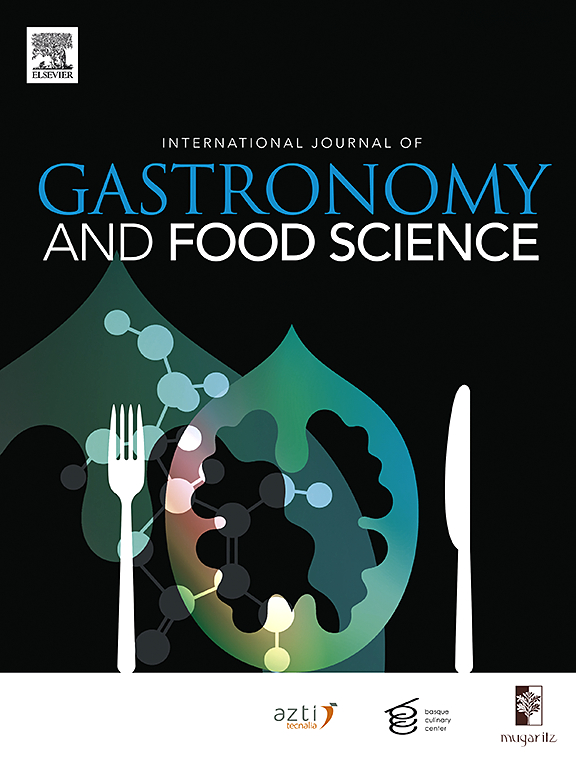不同香菇切形对香菇汤煮制过程中理化性质及营养成分的影响
IF 3.6
2区 农林科学
Q2 FOOD SCIENCE & TECHNOLOGY
International Journal of Gastronomy and Food Science
Pub Date : 2025-06-09
DOI:10.1016/j.ijgfs.2025.101226
引用次数: 0
摘要
在蒸煮过程中,不同的切形对香菇的理化性质有不同的影响。本研究采用三种不同的切形,考察了香菇在煮沸过程中的营养增溶作用。测定了香菇的蛋白质、多糖和总酚含量;测定了菌菇汤的固形物含量、电导率、pH、蛋白质、多糖、总酚、总黄酮含量;此外,还对蘑菇汤的流变特性进行了评价。结果表明,随着蒸煮时间的延长,汤汁中的营养成分含量呈现先升高后降低的趋势,但随汤汁切形的不同而有所不同。结果表明,全香菇对营养物质的保留效果较好;然而,由切成方块的蘑菇制成的汤显示出最高的营养溶解,其中蘑菇汤的营养含量明显高。事实证明,切丁香菇汤的黏度和剪应力明显高于其他样品(P <;0.05)。因此,将切成方块的香菇煮沸120分钟后,需要保留香菇中的营养成分,得到的香菇汤效果最好,营养成分保存最多。本研究有助于优化香菇的预处理和蒸煮方法,以保证营养成分最大限度地溶解和保留在汤料中。本文章由计算机程序翻译,如有差异,请以英文原文为准。
Effects of different shiitake mushroom (Lentinula edodes) cut shapes on the physicochemical properties and nutrients of shiitake mushroom soup during boiling process
Different cut shapes have different effects on the physicochemical properties of shiitake mushrooms during the boiling process. This study examined the nutrient solubilization of shiitake mushrooms during the boiling process by using three different cut shapes. In the study, the protein, polysaccharide, and total phenol contents of the mushrooms were determined; the solids content, conductivity, pH, protein, polysaccharide, total phenol, and total flavonoid contents of the mushroom soup were also determined; besides, the rheological properties of the mushroom soup were also evaluated. The results indicate that the nutrient levels in the mushroom soup initially increase and then decrease as boiling continues, but the tendency differs with the differences in cut shapes. The result suggests that the retention of nutrients is better in whole shiitake mushrooms; however, the soup made from cubed mushrooms exhibits the highest nutrient dissolution, where the nutrient content of the mushroom soup is notably high. In fact, the viscosity and shear stress of the soup from cubed shiitake mushrooms proves to be significantly higher than the other samples (P < 0.05). Therefore, the nutrients in the mushroom need to be retained when the cubed mushroom had been boiled for 120 min, and the mushroom soup obtained is best with the nutrients preserved most. This study can help optimize the pretreatment and cooking methods of shiitake mushrooms to ensure that the nutrients can be maximally dissolved and retained in the soup.
求助全文
通过发布文献求助,成功后即可免费获取论文全文。
去求助
来源期刊

International Journal of Gastronomy and Food Science
Social Sciences-Cultural Studies
CiteScore
5.30
自引率
10.50%
发文量
170
审稿时长
45 days
期刊介绍:
International Journal of Gastronomy and Food Science is a peer-reviewed journal that explicitly focuses on the interface of food science and gastronomy. Articles focusing only on food science will not be considered. This journal equally encourages both scientists and chefs to publish original scientific papers, review articles and original culinary works. We seek articles with clear evidence of this interaction. From a scientific perspective, this publication aims to become the home for research from the whole community of food science and gastronomy.
IJGFS explores all aspects related to the growing field of the interaction of gastronomy and food science, in areas such as food chemistry, food technology and culinary techniques, food microbiology, genetics, sensory science, neuroscience, psychology, culinary concepts, culinary trends, and gastronomic experience (all the elements that contribute to the appreciation and enjoyment of the meal. Also relevant is research on science-based educational programs in gastronomy, anthropology, gastronomic history and food sociology. All these areas of knowledge are crucial to gastronomy, as they contribute to a better understanding of this broad term and its practical implications for science and society.
 求助内容:
求助内容: 应助结果提醒方式:
应助结果提醒方式:


